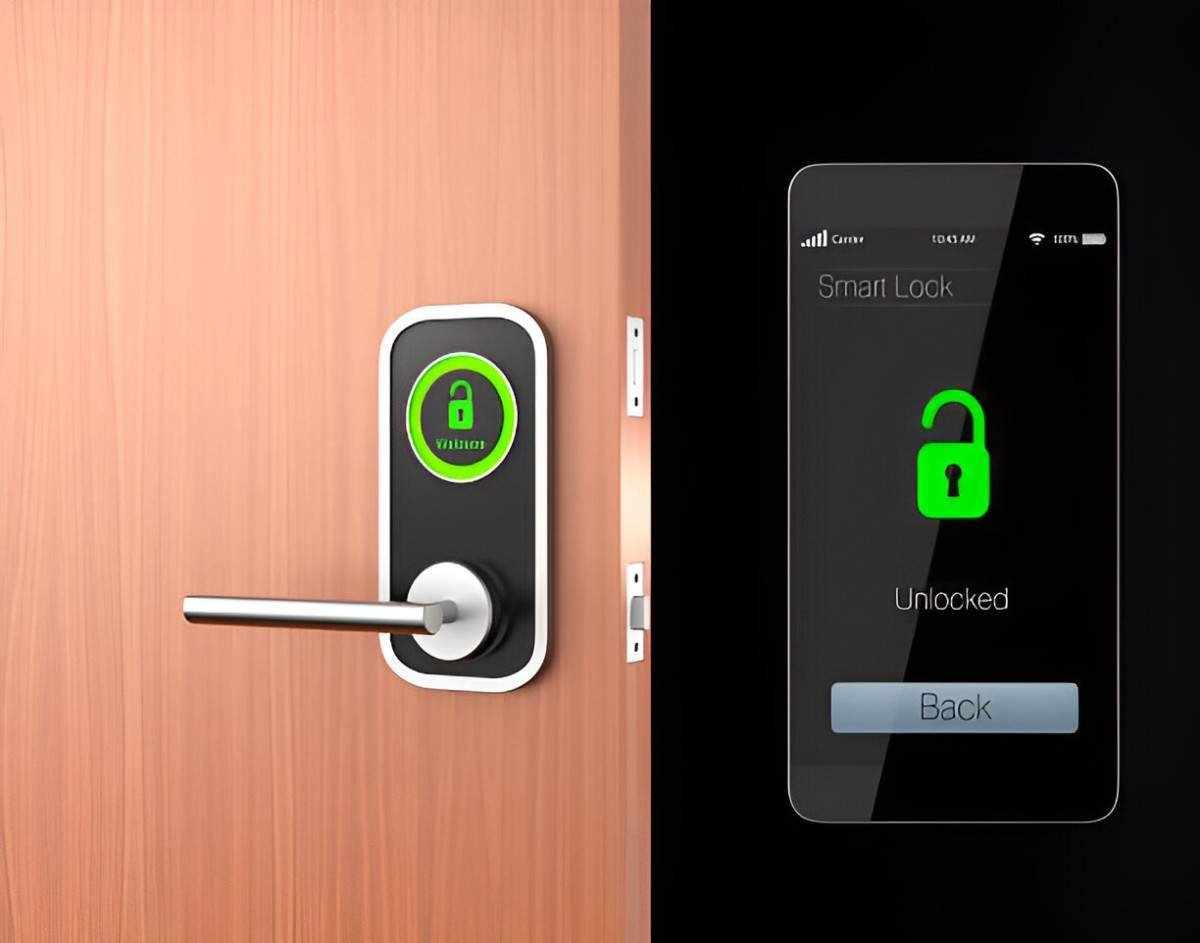When it comes to home security, one of the most important aspects is ensuring that your entry points are protected. Door locks are a primary defense, and with advances in technology, smart door locks have become a popular choice for homeowners looking to enhance security. But not all smart locks are created equal, and choosing the right one can be daunting.
In this guide, I’ll walk you through everything you need to know about smart door locks and how to choose the one that best suits your needs. From basic features to advanced security protocols, I’ll help you make an informed decision.
Table of Contents
What is a Smart Door Lock?
A smart door lock is an electronic locking device that connects to your home network, allowing you to lock and unlock doors remotely using your smartphone, tablet, or other devices. These locks come with various features, such as keyless entry, remote access, activity monitoring, and integration with other smart home systems. With the ability to control access from anywhere, smart locks offer convenience and enhanced security.
Types of Smart Locks
Smart locks come in various types, each designed to offer different functionalities. I’ll break down the main types, so you can understand which one fits your needs best:
1. Keypad Smart Locks
These locks use a numeric keypad to enter a code for unlocking the door. Some models allow you to create multiple codes, giving access to different people at different times.
2. Bluetooth Smart Locks
Bluetooth locks are a more common and affordable option. They typically pair with your smartphone via Bluetooth, allowing you to unlock the door when you’re within range.
3. Wi-Fi Smart Locks
Wi-Fi-enabled smart locks connect to your home Wi-Fi network, providing remote access from anywhere with an internet connection. This allows you to monitor and control your lock from anywhere.
4. Fingerprint Smart Locks
These locks use biometrics, specifically fingerprint recognition, to grant access. They offer high security and are ideal for those looking for a touchless entry option.
5. Z-Wave and Zigbee Smart Locks
These smart locks operate on low-energy wireless protocols like Z-Wave or Zigbee, typically used in home automation systems. They require a compatible hub to connect and communicate with other smart home devices.
Factors to Consider When Choosing a Smart Lock
When deciding on the right smart lock, you should weigh several important factors. Here’s a rundown of the most critical things I’d suggest you consider:
1. Security Features
Above all, security is the main reason we invest in smart locks. Look for features like two-factor authentication, encryption, tamper alarms, and the ability to set temporary access codes. Some smart locks can notify you if someone is tampering with the lock, which adds an extra layer of protection.
Key Security Features:
- Encryption: Ensures that your lock’s communications are secure and cannot be easily hacked.
- Two-Factor Authentication: Adds an extra layer of security beyond just a PIN or fingerprint.
- Auto-locking: Automatically locks the door when it’s closed.
- Tamper Alerts: Notifies you if someone is trying to manipulate the lock.
2. Ease of Installation
Smart locks come in two varieties: retrofit and complete replacement. Retrofit locks fit onto existing deadbolts, while complete replacements require you to swap out the entire lock system.
- Retrofit Locks: Easier to install as they can be attached to existing hardware.
- Replacement Locks: Require more work but might offer better security and durability.
Make sure to choose a lock that fits the door you have, as not all locks are compatible with every type of door.
3. Battery Life
Battery life is an essential factor to consider when choosing a smart lock. Some locks run on standard AA batteries, while others have built-in rechargeable batteries. You’ll want a smart lock that not only lasts a long time but also alerts you when the battery is running low. Some locks also have backup keys for emergencies.
Typical Battery Life for Different Smart Locks:
| Lock Type | Battery Life | Replacement Type |
|---|---|---|
| Bluetooth Lock | 6-12 months | Replaceable AA/AAA |
| Wi-Fi Lock | 3-6 months | Rechargeable |
| Keypad Lock | 12-24 months | Replaceable AA/AAA |
| Fingerprint Lock | 12-18 months | Rechargeable/AA |
4. Integration with Other Smart Devices
A smart lock isn’t just a standalone device. To maximize its usefulness, you’ll want to ensure it integrates seamlessly with other smart home devices like smart thermostats, security cameras, and voice assistants such as Amazon Alexa, Google Assistant, or Apple HomeKit. Some locks even allow you to set up automated triggers, like locking your door when you leave home or unlocking it when you return.
5. Remote Access
Remote access is one of the standout features of smart locks. If you travel frequently or need to let someone into your home while you’re away, a smart lock with remote access will make it possible. Wi-Fi and Z-Wave-based locks usually offer this capability, while Bluetooth locks might only work when you’re nearby.
6. Design and Build Quality
The design and build quality of a smart lock will affect its durability and aesthetic appeal. Some smart locks have a sleek, modern design, while others prioritize heavy-duty construction to withstand break-ins. Consider the material of the lock—steel is the most common for durable and secure locks.
7. Price
Smart locks vary in price, ranging from budget-friendly options to premium models. I recommend striking a balance between cost and features. Opt for a lock with a good range of functionalities while still fitting within your budget.
Price Range Comparison:
| Lock Type | Price Range | Features Offered |
|---|---|---|
| Basic Bluetooth Lock | $50 – $100 | Keypad, Bluetooth |
| Mid-Range Lock | $100 – $200 | Wi-Fi, App Control |
| Premium Lock | $200 – $300+ | Fingerprint, Smart Integration |
Popular Smart Lock Models
Now that we’ve covered the key features and considerations, let’s take a look at some of the top smart lock models available on the market today.
| Brand & Model | Type | Key Features | Price Range |
|---|---|---|---|
| August Smart Lock Pro | Wi-Fi, Bluetooth | Remote access, works with Alexa and Google Assistant, integrates with existing deadbolt. | $130 – $200 |
| Schlage Encode | Wi-Fi | Keypad entry, built-in Wi-Fi, integrates with Amazon Alexa, long battery life. | $150 – $250 |
| Yale Assure Lock 2 | Bluetooth, Z-Wave | Keypad, voice control via Alexa/Google Assistant, auto-lock function. | $150 – $250 |
| Kwikset Halo | Wi-Fi | Touchscreen, remote access via app, works with Alexa and Google Assistant. | $180 – $300 |
| Eufy Security Smart Lock | Bluetooth, Wi-Fi | Fingerprint scanner, keyless entry, remote access via app, tamper alerts. | $130 – $200 |
Conclusion
When selecting a smart door lock, it’s important to balance convenience, security, and price. Consider your specific needs: do you need remote access, integration with other smart devices, or advanced features like fingerprint recognition? Look for a lock with robust encryption and features like auto-locking and tamper alerts to ensure the highest level of security.
I’ve covered the main aspects of smart locks, but ultimately, the choice will depend on your personal preferences and home security requirements. Take the time to evaluate the options available and choose the lock that best fits your needs.
With the right smart lock, you can enjoy peace of mind, knowing that your home is secure and accessible only to those you trust.





